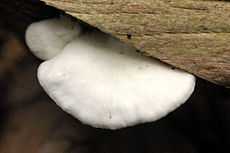Crepidotus mollis
| Crepidotus mollis | |
|---|---|
 | |
| Scientific classification | |
| Kingdom: | Fungi |
| Division: | Basidiomycota |
| Class: | Basidiomycetes |
| Order: | Agaricales |
| Family: | Inocybaceae |
| Genus: | Crepidotus |
| Species: | C. mollis |
| Binomial name | |
| Crepidotus mollis (Schaeff.) Staude | |
Crepidotus mollis is a species of mushroom. The common names of the species is soft slipper and jelly crep.
Description
The cap is kidney shaped. The cap is white when it is young and when it gets older, it turns ochre. The flesh of the cap is white and can be broken easily. The gills are pale brown and soft.[1] The cap is flabby and has brown spores.[2] The upper layer of the cap is elastic and can be stretched slightly at the margin.[3] The spores are short elliptic and smooth.[4] The spore print is snuff brown.[1] The stalk is rudimentary or lacking.[3] Crepidotus crocophyllus looks similar to this species[2] and is sometimes confused with it.[4] The species resemble a globe in moist weather.[5] The species has a relative large size compared to other species in the genus Crepidotus.[6] The fungus Hypomyces tremellicola is a parasite that deforms this species' cap.[7]
Edibility
The species edibility is unknown.[2] Since very little is known about the edibility of the mushrooms in the genus Crepidotus, none of the species should be eaten.[8] The authors Orson K. Miller and Hope Miller said that the species is too small to consider it edible.[4]
Habitat
The species grows in groups or overlapping tiers on hardwood.[2] The hardwood includes tree trunks, fallen branches, and sawdust. Rarely, the species grows on coniferous trees.[8] The species is widely distributed and very common.[2] The months that the species can commonly be found in are from July to September.[9] The species can be found in temperate zones of North America, South America, and The British Isles. It can also be found in Europe during spring, summer, and autumn.[10]
References
- ↑ 1.0 1.1 "Crepidotus mollis". First Nature. Retrieved 2010-01-23.
- ↑ 2.0 2.1 2.2 2.3 2.4 Arora, David (1986). Mushrooms demystified: a comprehensive guide to the fleshy fungi. 406: Ten Speed Press. ISBN 978-0-89815-169-5.
- ↑ 3.0 3.1 C. Roody, William (2003). Mushrooms of West Virginia and the Central Appalachians. University Press of Kentucky. p. 124. ISBN 978-0-8131-9039-6.
- ↑ 4.0 4.1 4.2 Miller Jr., Orson K.; Miller, Hope (2006). North American mushrooms: a field guide to edible and inedible fungi. Globe Pequot. p. 285. ISBN 978-0-7627-3109-1.
- ↑ Sayer Moffatt, Will (1909). The higher Fungi of the Chicago region. The Academy. p. 87.
- ↑ Gibson, Ian. "CREPIDOTUS in the Pacific Northwest". South Vancouver Island Mycological Society. Retrieved 2010-01-23.
- ↑ Authors, Multiple (2008). Mushrooms and other fungi of the midcontinental United States. University of Iowa Press. p. 71. ISBN 978-1-58729-627-7.
- ↑ 8.0 8.1 Pacioni, Giovanni; Lincoff, Gary (1981). Simon and Schuster's Guide to mushrooms. Simon and Schuster. p. 290. ISBN 978-0-671-42849-5.
- ↑ Authors, Multiple (1997). Mushrooms of northeastern North America. Syracuse University Press. p. 114. ISBN 978-0-8156-0388-7.
- ↑ "The North American Species of Crepidotus". MykoWeb. Retrieved 2010-01-23.